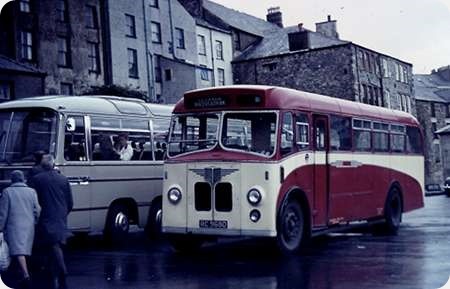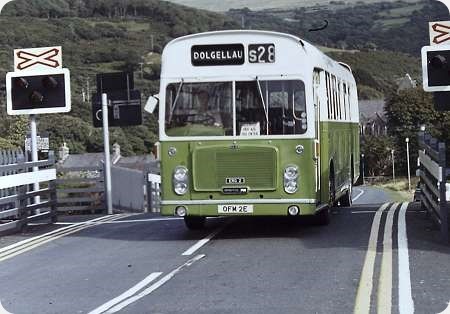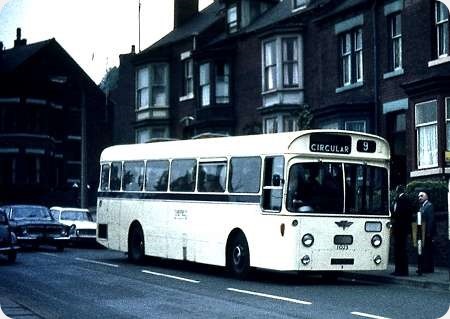
Express Motors
1947
AEC Regal I 0662
Willowbrook rebody 1958 FDP39F
RC 9680 was new to Trent in 1947 with a Willowbrook B35F body being lengthened and fitted with a new Willowbrook body in 1958. It was withdrawn by Trent in 1963 and is shown here four years later laying over in the shadow of Caernarvon Castle on a wet day in September 1967.
Photograph and Copy contributed by Ian Wild
21/07/20 – 06:41
A small correction to Ian’s caption; these vehicles were not given new Willowbrook bodies, the original bodies were lengthened at the rear to allow an extra double seat on each side and slightly at the front to fully enclose the cab and conceal the radiator. The other modification was a folding door, as seen, replacing the previous porch type entrance with a door at the top of the steps.
There were twenty of these conversions, the first one was given all new flush glazed windows mounted in rubber gasket, the remainder kept their original windows to reduce the conversion cost. They were all given new seats which allowed them to be re-classified as dual purpose but the new seats, although an improvement, were still rather spartan for 2-3 hour seaside services.
Chris Barker
22/07/20 – 06:58
It was a very successful conversion, IMHO, helped by the completely horizontal waistline instead of the dropping rear. I wouldn’t have guessed the bodywork wasn’t original. And here it is, still around, 20 years after being built!
Chris Hebbron
25/07/20 – 07:15
I agree with Chris Barkers comment about the horizontal waste line, helping to give the vehicle a more modern appearance. However when I see these vehicles I always feel that the frontal appearance could have been improved if – either the aluminium trim followed the bottom contour of the front windows, (and not a horizontal line) or the windows had a horizontal base instead of the angled finish. I’m sure their were good reasons for not altering the line of the windows (not least because they concealed the bulkhead and radiator and were part of the original half cab design). Nice conversion in any event.
John Rentell
09/08/20 – 05:53
Looks like a Creams (of Llandudno) Bedford VAL alongside. Could be BCC 1C ( https://flic.kr/p/7Qrw3K ), or BCC 6C.
David Williamson

Crosville Motor Services Ltd
1967
Bristol RESL6G
ECW DP42F
Crosville was the first to operate the then latest version of the Bristol RESL with shortened wheelbase and extended front overhang giving a wider entrance door arrangement. These were also the first with this design of ECW body characterised by the shallow flat windscreens.
Crosville put this batch of six into service in July 1967 on the long Rail Replacement service D94 between Wrexham and Barmouth. This served a sparsely populated area with Llangollen, Corwen, Bala and Dolgellau as the intermediate towns of any size. These six were synonymous with this route for many years but here in 1977 is ERG 2 in NBC days crossing the Cambrian Coast Railway line at Fairbourne on the S28 Tywyn to Dolgellau route. The NBC ‘Local Coach’ version of the leaf green livery with white upperworks looks pretty smart.
Photograph and Copy contributed by Ian Wild
10/07/20 – 06:14
I think these were the only dual purpose RESLs in the THC group of companies, although Midland General famously had two RESHs. Some of these vehicles were used elsewhere when brand new; ERG 2 was new to Llandudno Junction, and ERG 3 and 4 were at Caernarfon, although they soon migrated to the D94. Around 1974, A longer example, ERG 272 was transferred to Dolgellau Depot for use on the D94, and ERG2 was then used on other services from Dolgellau as shown here.
When new, these vehicles were painted cream with a green waistband, and they looked superb in that livery. ERG 3 is magnificently preserved in that livery.
Don McKeown
10/07/20 – 06:16
As far as the shorter length RE was concerned, the RESL seems to have been the almost universal choice for bus work but I wonder about it’s merits for dual purpose use, particularly if some of the front seats faced sideways. However, Crosville seemed to like them and as Ian says, used them on some long services although I’m not too sure about the prospect of sitting rather low down or sideways at the front for perhaps a couple of hours or so.
Midland General had a couple of short REs with this type of body but on the RESH chassis, with 43 dual purpose seats, all facing forward. Surprisingly, I believe they were the only ones bodied by ECW.
Chris Barker
16/07/20 – 10:16
United used the long version of the dual purpose RE on the five and a half hour 505 Newcastle to Edinburgh via Berwick service – not to my mind the most suitable of vehicles, and the seats were not especially comfortable. The route was jointly operated by Eastern Scottish who used Leyland Leopards and AEC Reliances with Alexander Y Type coach bodies. These were much more comfortable to ride on and seemed better suited to the route, although with the disadvantage of high entrance steps. The RELLs would be replaced after a few years by dual purpose RELHs with all forward facing seats and they in turn were replaced by downgraded RELH coaches, originally used on the Newcastle to London service. They would I suppose have been about ten years old then, but were still superb vehicle to travel on, however by that time, the service was being operated in two parts with passengers required to change vehicles at Berwick.
John Gibson

Sheffield Corporation
1968
AEC Swift 2P2R
Park Royal B53F
Sheffield took delivery of two batches of AEC Swifts in 1968. The 2P2R type was fitted with the AH691 engine, ideal for the Sheffield hills. The first 11 buses were single doorway for the Joint Committee B fleet as shown here. These buses were initially put to work on the Inner Circle services 8 and 9 despite these being category A services. 1023 is seen here so employed when just a few weeks old at Hunters Bar. The Inner Circle routes took one hour for a round trip serving the older and inner parts of the City. The small window beneath the nearside windscreen had a roller blind behind which could be set to either blank (as here) or Please Pay as you Enter as appropriate.
Photograph and Copy contributed by Ian Wild
29/06/20 – 06:21
Who knows? I could have been lurking within 1023. I was a pupil of King Edward VII School on Newbold Lane from 1964-1971 and these were my regular mode of transport to and from school from 1968. Fast and smooth but, in retrospect, not the equal of the RE. Ironic that, shortly afterwards, an order for the superb RE was changed for the flawed VRT.
David Oldfield
15/07/20 – 06:45
I think you and I spent many a happy hour waitiog for these Swifts and before that – whatever could be mustered from East Bank Road depot at that time in the morning, be it a 30ft long AEC Regent V with Weymann, Alexander or Roe bodywork, a PD3, Atlantean, Fleetline or even somethingg older. What a splendid mix was the Sheffield fleet right up to the 1970s.
The Swifts had a hard life climbing up and down the ferocious hills of the Steel City to Lodge Moor, Gleadless, Upperthorpe, Walkley and, as here, on the Inner Circle. Of course they never looked as good as this once taken over by the South Yorkshire PTE.
Philip Hanwell
17/07/20 – 07:33
Yes, it was a bit of a hotch potch just prior to the Swifts. Not sure about the B fleet Regents Vs or Fleetlines, but we certainly had the rest – and older. [Not to mention the fleet of almost retired Regent IIIs and PD2s used to ferry us to games at Trapp Lane and Castle Dyke.]
David Oldfield



